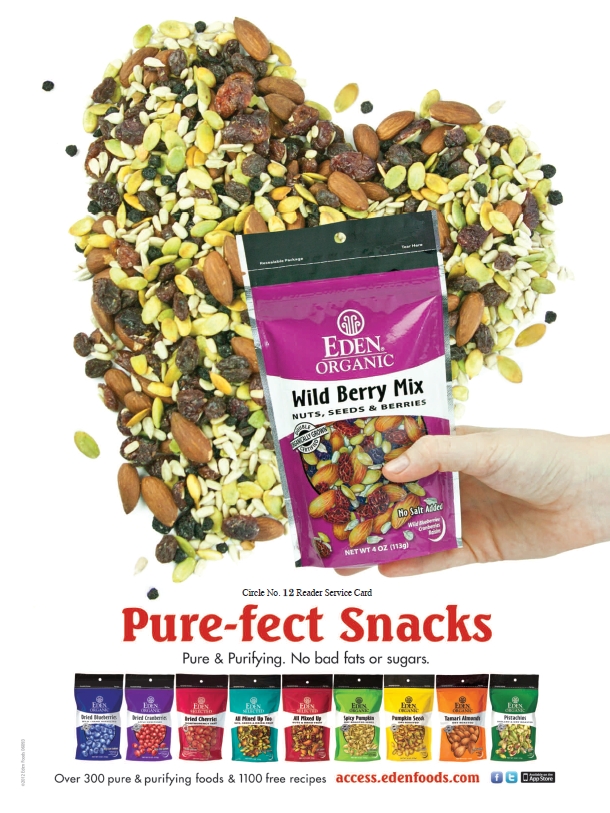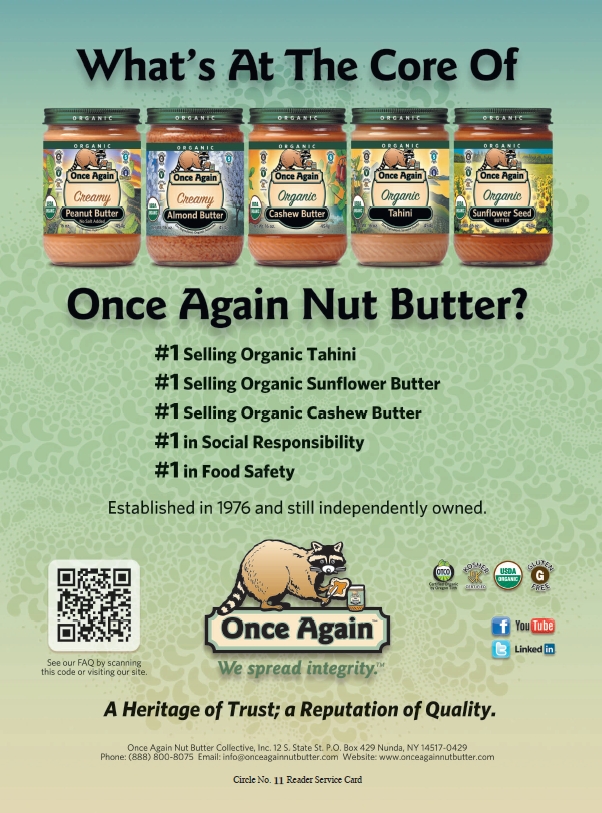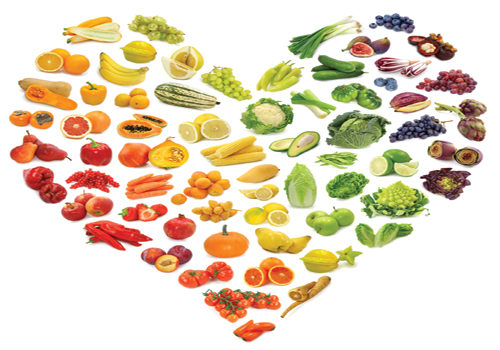Part Five of a Five-Part Series on Heart Health
The one organ in the body we can least afford to have lapse is the heart. Unfortunately, the majority of us routinely or even habitually lapse in protecting our cardiovascular health through diet. Part of this is simple dedication, but one also needs the know-how, as well as access to the right foods. A push in the right direction from a knowledgeable retailer doesn’t hurt, and you can go about doing this for your clientele by making your grocery section a heart-healthy haven.
Statistics on the nation’s poor heart health are as scary as ever. The Centers for Disease Control and Prevention reveals that the number of adults with diagnosed heart disease is at least 27.1 million. To place more emphasis on what this means for our daily lives, consider that the number of annual visits to physicians and hospitals by adults with ischemic heart disease alone (the kind caused by arterial blockages and high blood pressure) is 13.9 million (1). That’s a lot of very serious visits, from which too many do not return.
Prevention reveals that the number of adults with diagnosed heart disease is at least 27.1 million. To place more emphasis on what this means for our daily lives, consider that the number of annual visits to physicians and hospitals by adults with ischemic heart disease alone (the kind caused by arterial blockages and high blood pressure) is 13.9 million (1). That’s a lot of very serious visits, from which too many do not return.
But also consider that the American Heart Association (AHA) deems 80% of heart disease and stroke preventable (2). Perhaps the primary and most powerful mechanism of prevention is diet, so help your customers get started at stopping heart incidents before they happen.
Heart Health Essentials
The foodstuffs that make our hearts hum along most efficiently don’t resemble a rotating cast of characters. But even if this is not an area where flavors of the month get much play, there is always more evidence to be discovered in support of certain key heart-healthy foods, and more light to be shed on how best to include them in the diet.
In your attempts to create a heart-healthy array of foods for customers to choose from, emphasize variety. Experts say it is easier to stick to a heart-healthy diet when one switches things up from time to time (3). It is also important for customers to recognize that there is no magic bullet. Instead, they should look to many different foods on a consistent basis to acquire all the nutrients their hearts need.
Fish, especially salmon, can be a potent part of any heart-healthy diet, and this is mainly due to their rich supply of omega-3 fatty acids. Almonds, walnuts and other nuts are good for the heart for the same reason, in addition to the other important nutrients like vitamin E that they contain. Flaxseed and oatmeal, for both their fiber content and their omega-3s, are also good choices on a daily basis. Black or kidney beans offer several nutrients, including B-complex vitamins, which support healthy homocysteine levels (4). Green, leafy vegetables like broccoli and spinach are musts for their carotenoid content. Brown rice (as opposed to white rice) is valuable for its niacin, magnesium and fiber content. A little chopped garlic with one’s spaghetti is a great way to include this heart healthy vegetable in the diet. Finally, tea drinkers and dark chocolate fans can rejoice, because they’re already doing their hearts a favor when they partake in either of these (3).
 Then there is wine. As executive director of the organic winery Frey Vineyards LTD, Redwood Valley, CA, Katrina Frey is quite familiar with the benefits of red wine for heart health. “In 1992, Harvard researchers included moderate alcohol consumption in their ‘eight proven ways to reduce coronary heart disease risk.’ But it goes beyond that; red wine is specifically beneficial because of the presence of antioxidants, which come from the seeds and skins of red grapes,” says Frey. She explains that the antioxidants in red wine have been shown to reduce risks to the heart by supporting healthy levels of bad (LDL) and good cholesterol (HDL) and aiding in the body’s natural mechanisms to reduce blood clotting. Like any source of alcohol, red wine should always be consumed in moderation in order to help rather than harm the heart.
Then there is wine. As executive director of the organic winery Frey Vineyards LTD, Redwood Valley, CA, Katrina Frey is quite familiar with the benefits of red wine for heart health. “In 1992, Harvard researchers included moderate alcohol consumption in their ‘eight proven ways to reduce coronary heart disease risk.’ But it goes beyond that; red wine is specifically beneficial because of the presence of antioxidants, which come from the seeds and skins of red grapes,” says Frey. She explains that the antioxidants in red wine have been shown to reduce risks to the heart by supporting healthy levels of bad (LDL) and good cholesterol (HDL) and aiding in the body’s natural mechanisms to reduce blood clotting. Like any source of alcohol, red wine should always be consumed in moderation in order to help rather than harm the heart.
While all red wines contain beneficial antioxidants, Frey suggests that Cabernet Sauvignon and Petite Sirah lead the pack in the antioxidant department. Generally, the sweeter a wine is (sorry blush and white wine fans), the fewer antioxidants it contains. Many readers will be familiar with the term resveratrol, and it helps to note that this potent antioxidant is present in the skin of red grapes. It therefore is present in red wines, and accounts in part for their heart health benefits. This is why resveratrol is one of the factors in accounting for the French Paradox, which questions why the French have less of an issue with heart disease than other Western countries, when their typical diet is so full of fatty foods. The answer, in part, is thought to be their predilection for red wine.
Granola, that high-calorie hiker’s snack that is now found in countless granola bar formats, is of benefit to heart health because of its main ingredients. “Of course, there is a tremendous amount of research that shows oats reduce your cholesterol,” says Aaron Anker, chief granola officer, GrandyOats, Brownfield, ME. There is also research that a high-fiber diet, of which granola can be an important part, helps keep the heart in shape. Anker says that his company’s Classic 100% organic granola contains 20% of the recommended daily fiber intake. This granola is also loaded with nuts and seeds, both previously mentioned as go-to components in a heart healthy diet.
Anker also notes that some granolas include omega-3s, with theirs containing 610 mg per serving. This is an important consideration that can put a granola snack over the top as a heart-healthy choice. Finally, as part of a heart-healthy diet, whole grains of all kinds are essential and should not be neglected. In addition to oats, Anker says, “Many of our granolas contain other whole grains like wheat, triticale and rye.”
Sticking to It
 Knowing and doing can be a world apart when people decide to eat a heart-healthy diet. Therefore, a little structure can’t hurt, and can actually go a long way toward forming healthy habits. Patty Packard, M.S., R.D., director of nutrition and regulatory affairs at Vestcom, Little Rock, AR, whose company provides shelf-edge marketing solutions to grocery stores, describes the U.S. Food and Drug Administration’s (FDA) definition of “heart-healthy.” It means, officially, that food is low in fat, low in saturated fat, has limited amounts of cholesterol and sodium, and contributes at least 10% of the daily value of either fiber, protein, vitamins A and C or the minerals calcium or iron.
Knowing and doing can be a world apart when people decide to eat a heart-healthy diet. Therefore, a little structure can’t hurt, and can actually go a long way toward forming healthy habits. Patty Packard, M.S., R.D., director of nutrition and regulatory affairs at Vestcom, Little Rock, AR, whose company provides shelf-edge marketing solutions to grocery stores, describes the U.S. Food and Drug Administration’s (FDA) definition of “heart-healthy.” It means, officially, that food is low in fat, low in saturated fat, has limited amounts of cholesterol and sodium, and contributes at least 10% of the daily value of either fiber, protein, vitamins A and C or the minerals calcium or iron.
It is a standard to which her company adheres in its shelf marketing materials. “The AHA’s Heart Check program also uses the FDA guidelines to certify foods as ‘heart-healthy’ with a checkmark on food packaging,” Packard says. These guidelines will help consumers concerned about eating heart healthy as they check nutrition labels. The AHA check mark, similarly, is an even quicker way to tell that a product is likely a good choice.
One also can’t go wrong by following the U.S. Dietary Guidelines for Americans, though it helps to inform customers that the old food pyramid is now a round plate. “A simple way to adhere these guidelines is by following the USDA’s ‘MyPlate.’ MyPlate has replaced the Food Pyramid as the primary dietary guideline and breaks down the ideal portion sizes for each food group,” Packard explains.
This roadmap to heart health recommends that half of one’s plate consist of fruits and vegetables, one-quarter of it be grains, preferably whole grains, and that 3 oz or so be devoted to protein, all accompanied by a glass of skim or low-fat milk. Though this rigid meal-making guide will quickly grow tiresome for most, it is at least a framework with which to begin being conscious of healthy dietary proportions. Packard notes that these recommendations can be accessed at www.choosemyplate.gov.
Consumers can also become accustomed to seeking out nutrition data at the shelf edge in many stores. “Thousands of food retail stores have implemented our shelf-edge nutrition program that is integrated with the USDA data and scores those items for positive attributes,” Packard says. Once the journey to heart health through diet begins, the key for consumers is not to bite off more than they can chew. “Start any new eating plan with baby steps. Set small realistic goals that you know you could follow such as ‘Tomorrow, I will eat one meal following MyPlate,’” says Packard, adding that one can ratchet things up from there.
Beyond naming specific foods that benefit cardiovascular well-being, there are general nutritional guidelines with which individuals should familiarize themselves, starting with what to avoid. Anker says, for instance, that a big difference between his company’s granola and some others is the lack  of sugar. Recent studies show that excess dietary sugar can increase the risk of heart disease. Anker cites a recent article in The New York Times covering research that found just one 12-oz sugar-sweetened drink per day can cause a spike in heart disease risk (5). Low-salt varieties of foods like granola are also suitable choices for heart health.
of sugar. Recent studies show that excess dietary sugar can increase the risk of heart disease. Anker cites a recent article in The New York Times covering research that found just one 12-oz sugar-sweetened drink per day can cause a spike in heart disease risk (5). Low-salt varieties of foods like granola are also suitable choices for heart health.
Teaching your customers a little bit about distinguishing good fats from bad can help, too. Anker says that healthy fats like those found in nuts and seeds are good for you. The LDL cholesterol commonly associated with red meat and other sources is what to watch out for.
Then, there are those foods that can help the heart when consumed in moderation. Though excessive alcohol from any source can harm long-term cardiovascular health, red wine consumed responsibly can, for reasons stated, actually benefit the heart, according to Frey.
Lastly, in a heart-healthy diet there are many unquestioned staples. Whole grains, vegetables, high-antioxidant fruits and high levels of omega-3s are among them. As for how to incorporate these items into one’s routine, Anker suggests the easy, palatable addition of granola or oatmeal to a person’s daily breakfast, a habit that could put many of your customers well on their way to achieving their nutrition goals.
Labeling Heart Health
Food companies are ever eager to share the healthful qualities of their products, particularly in the heart-health category. That is why it is incumbent upon you as a retailer to be familiar with what claims FDA has allowed, and what to look for when a company’s marketing is overstepping these regulatory lines. Packard recalls that FDA has its official definition of “heart-healthy” (low fat, at least 10% of the daily value…).
But apart from this basic recognition, FDA allows food manufacturers to make “qualified health claims” for heart healthy foods, given their products contain ingredients from a select and exclusive group. This group includes all types of nuts, and the claim that can be made on packaging goes like this: “Scientific evidence suggests but does not prove that eating 1.5 ounces per day of most nuts [such as name of specific nut] as part of a diet low in saturated fat and cholesterol may reduce the risk of heart disease.”
The other claims that fall into this group are for walnuts, omega-3 fatty acids, B-vitamins, monounsaturated fatty acids from olive oil, unsaturated fatty acids from canola oil and lastly unsaturated fat from corn oil. Each of these product groupings is allowed a similar claim, with each referring to a specific condition such as vascular disease or coronary heart disease. Each is also subject to specific stipulations regarding serving size and the way the food is prepared, which a product must cater to in order to use the qualified health claim (6). There are also more general allowable health claims that are not qualified, but these regard general categories like soluble fiber for coronary heart disease and soy protein for coronary heart disease.
Wine is a different story, says Frey, stating, “The Alcohol and Tobacco Tax and Trade Bureau (TTB), which regulates all alcohol labeling, does not allow wine makers to include any claims about wine’s role in heart health at this time.”
Packard emphasizes that for retailers, it is important to consider how they organize any “Health and Wellness” program in their store. This means making sure that anytime a food is termed “Healthy” in this context, it meets the FDA and USDA standards. “Just because a product is low in fat or saturated fat, does not automatically make that product ‘Heart Healthy,’” she says. WF
References
1. “Heart Disease,” Centers for Disease Control and Prevention, May 16, 2012, http://www.cdc.gov/nchs/fastats/heart.htm, accessed Sept. 4, 2012.
2. “American Heart Association,” http://www.heart.org, accessed Sept. 4, 2012.
3. “25 Top Heart-Healthy Foods,” http://www.webmd.com/food-recipes/features/25-top-heart-healthy-foods, accessed Sept. 4, 2012.
4. “B Vitamins Reduce Stroke, Heart Disease Deaths,” http://www.webmd.com/heart-disease/news/20100415/b-vitamins-reduce-strokes-and-heart-disease-deaths, accessed Sept. 4 2012.
5. “Risks: Sugary Drinks Linked to Heart Disease,” http://www.nytimes.com/2012/03/20/health/research/sugar-sweetened-drinks-linked-to-heart-disease.html?_r=1, accessed Sept. 4, 2012.
6. “Summary of Qualified Health Claims Subject to Enforcement Discretion,” http://www.fda.gov/Food/LabelingNutrition/LabelClaims/QualifiedHealthClaims/ucm073992.htm#qccardio, accessed Sept. 4, 2012.
This heart health series is sponsored by
Published in WholeFoods Magazine, October 2012












